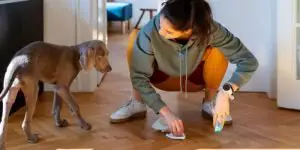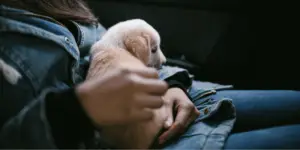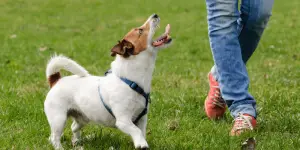
Moving Home With A Dog
- Written by Joshua Gordon
- Last updated
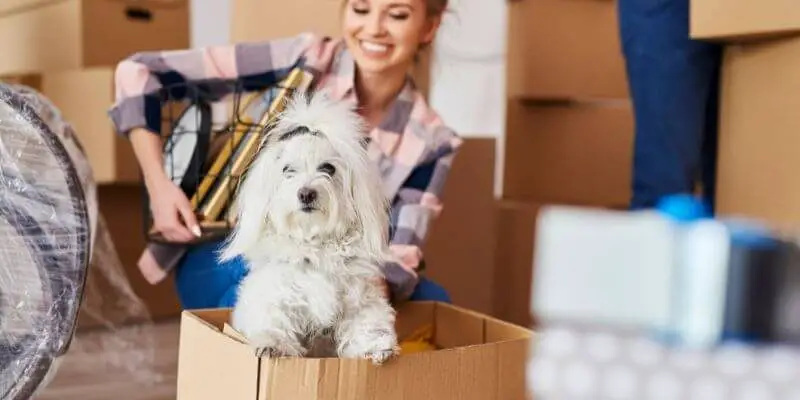
Key takeaways
- Keep your dog’s routine the same
- Register with a new vet and update your dog’s microchip details
- Use a car crate or dog seatbelt/harness to keep your pet safe
- Pack your dog’s things last
- Keep your dog stimulated while your unpack
- Explore your new house with your dog together
In this article
Moving home with a dog – What to Expect
Moving house can be a stressful and frustrating ordeal, both for you and your dog. Dogs can pick up when you’re feeling a little tenser than usual, so they know when something is different or about to change.
Plus, being put in an unfamiliar environment with new sights, smells, and sounds is going to be quite scary! That’s why it’s important to make a few preparations before and after you move house, as this will help reduce your pup’s anxiety and fear of the situation.
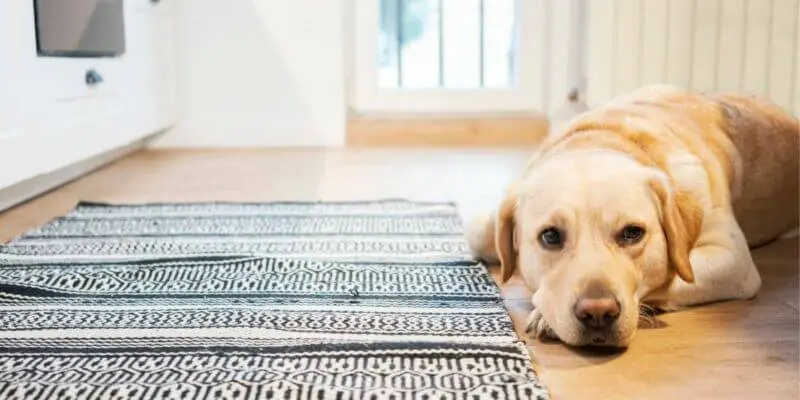
Before moving – get your pup prepared
Moving house can often take several weeks or months and the process of getting your dog accustomed to the move is the same for an 8-week-old puppy or full-grown adult.
Keep your dog’s routine the same
One of the most effective ways of keeping your dog calm before you move house is simply to keep their routine the same.
Dogs quickly know when something is wrong or different if their routine changes. By continuing to feed, walk, and play with your pooch at the same times each day before the move, they’ll feel more secure in their environment.
Pack your dog’s belongings last
Wait until the last possible moment to pack your dog’s belongings as this will help them feel more in control of the situation.
Speak to your vet for advice
If your dog is a poor traveler, it’s worth getting in touch with your vet to see if they can prescribe something to help settle your pooch during the car journey. For instance, they may offer an anti-nausea medication if your dog suffers from motion sickness.
If you’re moving to a different country, your vet will also assist you with any paperwork that you may need to fill in. This itself is a long process that can take many months, so the sooner you do it, the better.
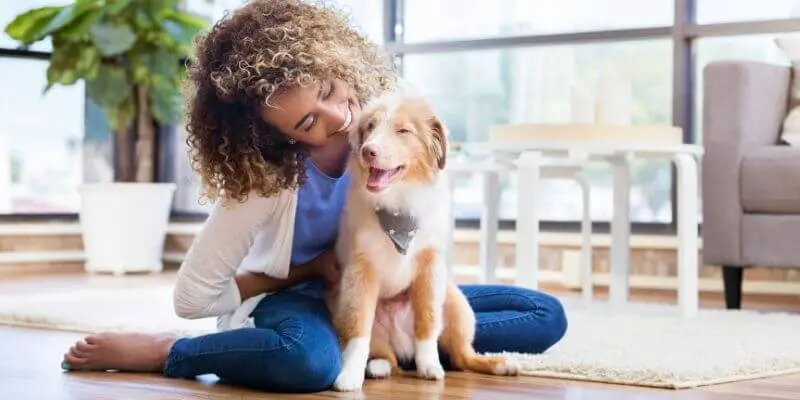
Use a plug-in diffuser for dogs
Plug-in diffusers for dogs can be helpful when you’re moving house, especially if your pooch is prone to anxiety. They contain dog appeasing pheromones (DAP), the same pheromones female canines produce after they’ve given birth to puppies.
This pheromone effectively calms dogs during stressful situations and is one of the best treatments for nervous pups and those suffering from separation anxiety.
Register with a new vet
If your current vet is far away from your new house, make sure you register with a new veterinary practice as soon as possible.
Keep your dog’s microchip details up to date
Although the day of the move will be stressful, it’s important to change your dog’s microchip details to your new address and contact number. You’ll also need to update your dog’s collar tags too.
In unfamiliar surroundings, your dog may try to escape and be unable to find their way home. Doing this step straight away will help make sure your pooch is returned to you if they decide to go exploring!
Check the garden of your new house
Before you take your dog to your new house, check the garden so you can make sure it’s safe and secure for your pooch’s arrival. Fill in any holes in the fence, block off potential escape routes, and remove poisonous plants.
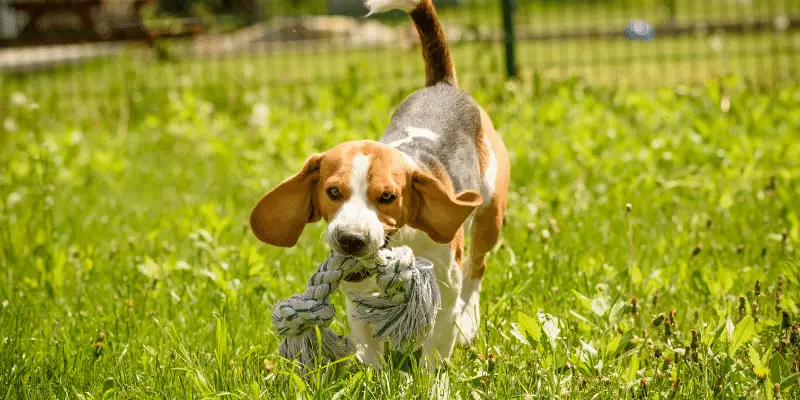
Plan ahead to avoid surprises
Moving house with a dog requires a little bit of extra planning to ensure the experience goes as smoothly as possible, for both of you. For instance, it might be worth asking a friend or family member to take care of your pooch on the day of the move.
That way, you can focus on getting your belongings to the new house and unpacking without also having to worry about running around after your dog. This will not only keep them safe from all the hecticness, but it will also give you time to clean up the new house to make it more comfortable for your dog.
Another thing to consider is how you’re traveling to your new home with your dog – are you going by car, train, plane, etc?
If going by car, you’ll need to either use a car crate or a dog seatbelt/harness to keep your pet safe during the journey.
Moving day – what to do with your dog on moving day
On the day of the move, you’ll understandably be busy loading your belongings into the moving van and unpacking. However, you’ll also need to make some time for your dog to help ease them into their new environment.
Safety first
Safety should be your first priority when moving home with a dog or puppy. As mentioned earlier, it might be best to ask a family or relative to look after your dog so you can focus on loading the car/truck and unpacking.
You can then bring your pooch to your new house during the evening when things have calmed down and you’ve had time to unpack.
During the journey to your new house, make sure you use a car crate or dog seatbelt/harness so you can keep your dog safe in the car.
If your dog suffers from motion sickness or anxiety during travel, it might be worth talking to your vet to see if they can offer your pet an anti-nausea/anti-anxiety medication to make the trip easier.
Keep your pup stimulated while you’re busy unpacking
Once your pup is at your new house, you should set up a safe area for them to relax in while you unpack. You should unpack your dog’s belongings first so they have things that smell like their old house.
Give your dog a new toy or a tasty treat to play with to keep them entertained as you clean up the new house and unload the car/truck. Puzzle toys, Kongs, and long-lasting chews are all great options to keep your pooch occupied.
Reassure your dog but don’t provide more attention than usual
While it’s important to reassure your pet on the day of the move, try not to provide them with more affection than normal as this could make them think that there is something to be anxious about. Treat moving day like any other day – keep your pooch’s routine the same and be calm.
Your dog will sense if you’re feeling nervous or stressed, which may make them act similarly!
Scent swap
A new house will smell a lot different to your dog and will not feel like “their” home straight away, so scent swapping can be useful for helping your dog feel more secure in unfamiliar surroundings. Gather blankets, pillows, toys, bedding, etc, that smell of your old house to help settle your dog in quicker.
You can also rub a cloth over your dog, then wipe it across the furniture and corners of your new house to spread their scent around.
Helping a dog or puppy adjust to their new home
Once you’ve finished unloading your belongings and had a bit of time to unpack, you should focus on helping your dog adjust to their new home.
Explore the new area together
Make sure your new house is secure, then allow your dog to explore their surroundings when they feel ready. Joining your pooch on the tour may help them feel more comfortable and safe, especially if your dog is particularly anxious.
Don’t force this process as it will only make your pet warier. If your pup is especially distressed or fearful, take them back to their safe area and try again later when they’re feeling more confident.
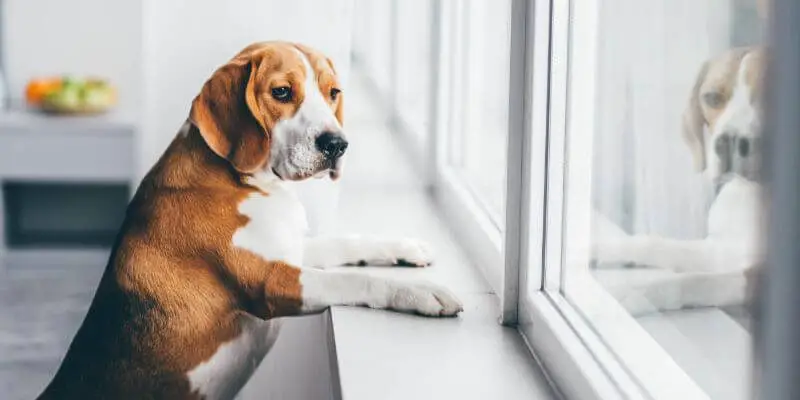
Prepare for accidents
Moving to a new environment can be very stressful for dogs, so even house-trained pets may have the odd accident or two until they have settled in. As frustrating as it can be to see your dog regress in training, be patient and avoid punishing your pooch.
Instead, encourage and praise your dog when they toilet in the right place. If they have an accident, show them the area you want them to do their business.
If your dog or puppy is having a lot of accidents, you may need to begin the potty training process again.
Give the new owners of your old house your new contact details
Some dogs may attempt to return to their old house if they escape, so it’s worth giving the new owners of your old house your address and phone number. Help your pooch associate their new house with positive things, such as fun activities, walks, and meal times.
Final thoughts
Moving home with a dog doesn’t have to be a scary experience as long as you properly prepare your pooch and help them adjust to their new house.
A drastic change in environment can be very stressful for dogs, so expect a few accidents and a bit of misbehaving until your pooch settles into their new home. Keep your dog’s routine the same and only give them pleasant experiences in their new home to help make the transition easier.
Before you know it, your dog will forget all about their old house and you can focus on making more happy memories together!
References
- https://www.ncbi.nlm.nih.gov/pmc/articles/PMC2839826/
- https://www.vets4pets.com/pet-health-advice/dog-advice/moving-house-with-your-dog/
- https://www.petmd.com/dog/behavior/how-do-calming-dog-and-cat-pheromones-work
- https://www.rover.com/uk/blog/moving-with-your-dog/
- https://www.bluecross.org.uk/advice/dog/moving-house-and-travelling-with-dogs


